 |
Robert Stevens
Robert started Bunnyfoot, the UK’s largest User Experience consultancy in 1999. He has to date spun out two companies from Bunnyfoot; Acuity ETS, the World’s largest reseller of Tobii eye trackers and Think Eye Tracking a research company dedicated to demonstrating the benefits of eye tracking to research agencies and consumers of market research.
Read the full biography here. |
Two Things I Love About Eye Tracking
By Robert Stevens - 5 March, 2010
I started using eye tracking on a daily basis seven years ago. Tobii launched the ET17, the first commercially viable eye tracker for mass market research and I purchased the first one ever sold to a commercial organization.
So eye tracking and I go back a long way, and in that time I’ve learned a lot about it. Two of the things that I love about eye tracking are:
| |
 |
Actionable results
|
| |
 |
Intuitive and easy to understand reporting |
So how does it deliver these? Here’s an example from a video game user test.
|
|
|
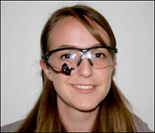 |
| |
The eye tracking on this piece of research was done using a head mounted eye tracker by Locarna. This type of eye tracker is particularly useful for shopper research or as we will see, other real World situations such as user testing games that have novel or complex interfaces and peripherals. |
|
One of the most successful areas for growth in the last decade has been the games industry; it grossed $11.7 billion in the US alone in 2008 which, surprisingly for some, is more than the film industry. This increase has largely been driven by a swell in the types of games available, appealing to ‘non-traditional gamers’. The Wii and DS hardware platforms from Nintendo and rhythm games including Guitar Hero, Band Hero and DJ Hero have introduced games to huge segments that are/were not ‘traditional gamers’.
In the clip below we eye tracked a novice gamer whilst he played DJ Hero for the very first time. The green cross hair shows where the gamer is looking as he plays the game and looks at the game control device; a stylized DJ Deck. In DJ Hero the gamer must press buttons on the DJ Deck that corresponds with beats on a ‘highway’ in the game. He gains points for being accurate: if he is not accurate the audience will boo him off the stage. The action can happen fairly quickly so I've taken some stills from the eye tracking video to make sure the points are clear.
|
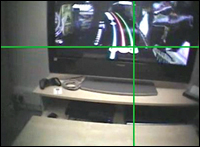 |
|
|
| |
|
Despite looking exactly where he needs to (at the gem on the strikeline)... |
|
|
|
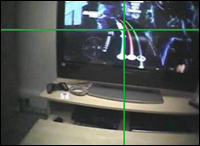 |
| |
The gamer misses the beat. He says "Man I'm not doing too well with this." |
|
|
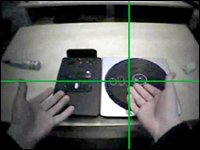 |
|
|
| |
|
The gamer looks at the controls and complains that the controls are the wrong way around, the green button is to the left, but on the highway on screen the green track is to the right. |
|
|
|
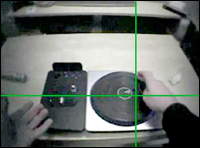 |
| |
A quick adjustment gives the correct mapping of buttons on the deck to the highway, blue on the left, green on the right. |
|
|
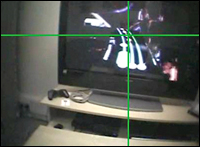 |
|
|
| |
|
The gamers' experience improves immediately, and he even starts to whistle along to the tune. The head mounted eye tracker shows he is looking further up the highway, at the gems that are coming into play rather than the ones on the strike line. |
An examination of the deck reveals the problem; the DJ Hero logo is the 'right' way up, when the buttons on the deck are incorrectly mapped to the highway in the game.
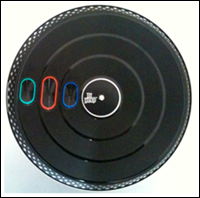
The cue to have the DJ Hero logo the correct way up is intuitive and very strong - this led the novice gamer to have the DJ Deck 'upside-down' and so he made mistakes even when he was looking in the right place, at the right time to hit the beat perfectly. He found this very frustrating!
A traditional gamer may have overcome this usability problem with relative ease. But as such games appeal to new segments that are not familiar with game play and how control devices work it is imperative for games companies to create out of the box gaming experience that are intuitive and easy to use.
At Think, we typically test five or six representative users per demographic, when running user experience studies. Each interview typically lasts an hour and includes a qualitative interview. Although we can and do run studies in people’s homes it can be cost-prohibitive so we most often pre-recruit to a central location and/or run hall testing with in-street intercepts from our facility based in Reading town centre.
Working in a central location also allows the client to view the testing and the immediacy of the clips makes reporting incredibly easy, we don't have to present deck after deck of slides proving points - the client can see for themselves what real users actually do. In addition the client goes away with something they can immediately show to their internal stakeholders - as I said, actionable that very day.
In future articles we will look at using larger samples to understand how eye tracking can provide quantitative results and actionable results for different types of media.

Robert Stevens
Comments on this article

Want to share your thoughts...?
NOTE: Please note that this board is moderated, and comments are published at the discretion of the site owner.
|